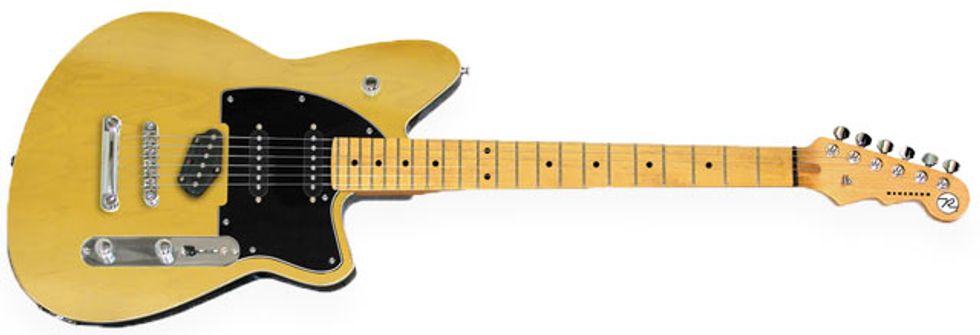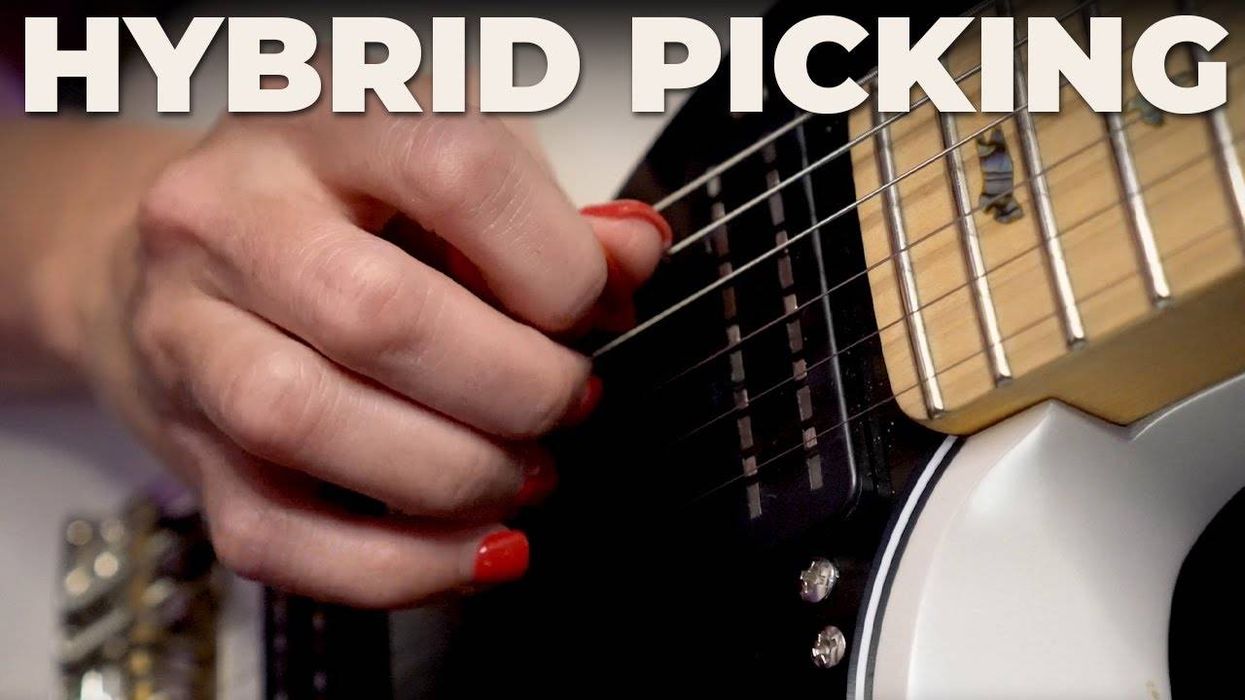| Download Example 1 Bridge & Middle, Bass Contour 30% Download Example 2 Bridge only, Bass Contour 30% Download Example 3 Bridge only, Bass Contour Open Download Example 4 Neck & Middle, Bass Contour open Download Example 5 Neck only, Bass Contour 30% |
Joe Naylor's Reverend Guitars out of Michigan has evolved their offerings since debuting in 1996 into an impressive line of bolt-on and set neck electric guitars. On the way, they have developed a large, cult-like following of players who appreciate the company’s high quality at affordable prices. Reverend’s models encompass stylish originals and signature models for more esoteric, often underappreciated artists. The guitar I received for review is one of their newest non-signature models: the Six Gun.
The Nuts and Bolt (Ons)
The Six Gun is one of Reverend's Bolt-Ons, and has a very classic, yet totally original look. Part classic Cadillac, part Fender, the korina body wears comfortably. All of Reverend’s Bolt-On guitars feature one-piece maple 25.5” scale necks. The neck definitely fits into the vintage category: 12" radius, medium thickness C-profile with 22 medium jumbo frets. The neck is comfortable, with a smooth satin finish, and bending notes and vibrato was a breeze. My Six Gun had the Vintage Clear finish, which ships with a maple neck and fretboard. Reverend also offers a rosewood fretboard on the Six Gun Metallic Blue model. The headstock has six inline Reverend Pin Lock Tuners—a great addition from Reverend. The tuners have thumbscrews where the gear cover would normally be, which allows you to clamp the string into the post for fast and slippage-free stringing. The guitar stayed in tune very well, and the few times I had to grab a tuner it felt great and turned smoothly.
The Six Gun has two Strat-style single-coil pickups in the neck and middle positions, and a fatter Tele-style pickup in the bridge. All three pickups are made by Reverend and have ceramic magnets. The middle and neck pickups are medium output, with custom spacing of the steel polepieces to ensure they properly line up with the strings. The neck and middle pickups are placed in the classic Stratocaster formation and the bridge pickup is placed in a Telecaster slant bridge position. The bridge pickup has extra windings to Joe Naylor's specifications for a hotter vintage tone. All three pickups are nicely balanced so that switching from one to the other or using various pickup combinations did not cause any drastic changes in volume.
The bridge pickup has a brass baseplate that sits a little high—it might take some playing adjustment for players used to lower profiles. The overall set up of the guitar is nicely done however, and I had no string height issues on the fretboard. Resting my wrist behind the Tune-o-Matic bridge (a bridge that lends itself to digging in), put my hand in a position to keep from plunging in too deeply. One note about the placement of the bridge pickup is that you are very limited in pickup height adjustment. If you like to keep a decent amount of space between the strings and bridge pickup for feedback, it's not really an option here. The bridge pickup sits close enough to the strings that it was easy to slap the plectrum against it. The neck and middle pickups sit in the body, so no right hand issues there.
Shooting Straight
All three of the Six Gun’s pickups sounded great alone and together. The neck pickup was pristine and bluesy, and I got a lot of sweet crunch on the bridge pickup. Lead lines using the bridge pickup gave me plenty of cut and sustain. It was bright without being strident, and thanks to the bass contour knob (more on that in the next paragraph), leads up and down the neck had excellent presence and body beyond what I would associate with an unmodified and unprocessed Fender. I am happy to say soloing with the neck pickup gave me shades of David Gilmour, even though I play review guitars sans effects. I rarely use middle pickups on their own. To me, they've always been the wingman pickup for the other two. A good middle pickup is measured by the tone you get when combining it with the bridge or neck pickup. The neck and middle pickups together sounded smooth—even jazzy—with a nice, mellow bite, while the bridge and middle pickups together had a sharper bite with a totally manageable single-coil twang. . Overall I really dug the way the guitar sounds on all five pickup settings.
Something unique to the Reverend Bolt-Ons is the Bass Contour Control found on the upper horn of the instrument. It is a passive trim pot that allows you to roll off the bass and therefore re-voice the pickups. I found this knob very useful. Wide open, the guitar is very beefy—especially for a single coil. Roll it off about 30% or so to introduce some Tele brightness, and further to really push the highs and accentuate the cutting tones. I found myself using this knob quite a lot. I often kept it rolled off just shy of the Tele stage, which gave me a vintage brightness without losing too much bottom. I then opened it up to solo with a fatter, big-bottom tone. With the Bass Contour Control wide open, this single coil guitar had a bottom that rivaled most humbuckers. It really was a best-of-both-worlds kind of tone, giving the instrument a versatility that could earn it a starting position in your guitar line up.
The Six Gun also employs Tele-style controls—a single pair of steel knurled volume and tone knobs, plus a five-way switch in place of the classic Tele three-way. It is important to note that the Six Gun's volume knob does not lose the highs when turning its volume down—I wish more guitars were wired this way from the factory.
Speaking of the factory, Reverend Guitars, while fitting the boutique bill to a tee, are constructed in Korea and set up at their headquarters in Michigan. If that gives you a moment of pause, I strongly suggest playing one before passing judgment. No doubt, being built in Korea factors into the Six Gun's attractive street price of $699.
The Final Mojo
The Reverend Guitars Six Gun has a lot going for it, and tone is top of the list, as it should be. It sensibly combines some of the best designs known to guitar-dom (Tune-o-Matic bridge, stop tailpiece and Tele and Strat pickup configurations), with new, very usable features like the Bass Contour Control and Pin Lock Tuners. Joe Naylor must know what he's doing because this guitar sounds really great.
Buy if...
you want a great looking guitar with great Strat/Tele-plus tone and innovative features.
Skip if...
you need a low profile instrument, or you have a tendency to dig when picking.
Rating...
























